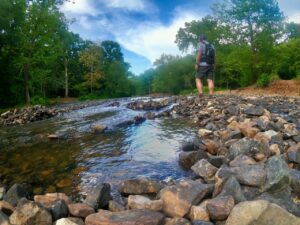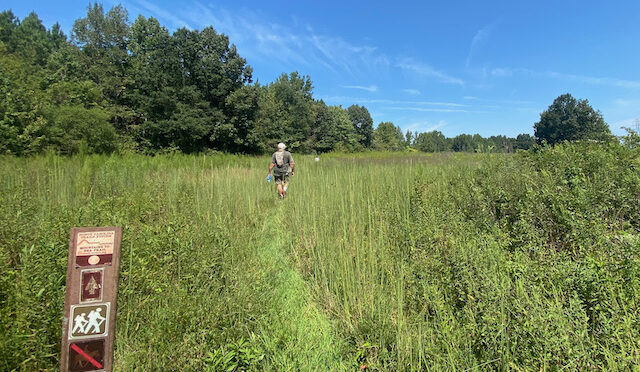You like the idea of hiking solo, but the thought of being alone in woods makes you uneasy, at best.
Most of us hike in the protective bubble of a group, and that’s a good thing. You have people around should anything happen: a twisted ankle, overheating, you emerge from deep conversation to discover you have no idea where you are. Critters, including the few potentially harmful ones, are more likely to scatter when they hear a group approach. Strangers present less of a danger when you’re in a group. And there’s the social element.
All good things. Usually.
But consider: Those critters that scatter when they hear a mob approach? That’s one less coveted experience you’ll have in nature. Strangers present far less of a danger on the trail; in fact, they’re likely to advise you about something up ahead that you shouldn’t miss; at the very least, you’ll probably get a smile and a hello. And frankly, sometimes, you don’t want the constant squawk of conversation: You want that disconnected solitude that is such plus when you’re in the woods.
And yet, there’s that nagging fear factor. A factor likely born of the unknown, since you likely haven’t tried it yet. As Irish author James Stephens once noted, “Curiosity will conquer fear even more than bravery will.”
So, aren’t you the least bit curious about what hiking alone is like? You must be if you’ve read this far.
Today, we offer some quick tips about hiking alone, then an opportunity to explore solo hiking further.
When to hike

At least at first, hike when you know there will be other people on the trail. Yes, a goal of hiking alone is to be alone But initially, you’ll want the assurance of others nearby. Here’s when hikers are more likely to be on the trail:
- Winter: Saturday 10 a.m. until 4 p.m.; Sunday afternoon.
- Spring: All day Saturday and Sunday; early evenings weekdays one Daylight Saving Time kicks in.
- Fall: All day Saturday and Sunday
- Summer: mornings between 7 and 9 a.m.; evenings from 6 to 8 p.m. Saturday morning, Sunday morning.
Where to hike
Where’s a good place to hike solo? Start with:
- Trails you know. You’re familiar with these trails; even if you’ve only hiked them with a group and you’ve followed the leader, you still have a better chance of recognizing and following the trail, even a trail that’s crossed multiple times, or a route consisting of multiple trails.
- Trails with a cell signal. Even in an urban area, not all trails have cell service — and thus, a way to summon help if the need arises. Eventually, you may feel comfortable enough to hike remote locations without service. When that happens, you’ll want to invest in a GPS tracking system, such as Spot, In-Reach or Zoleo.
Always take the 10 Essentials
Hiking with a group, if you scrape a knee or run out of sunlight, someone on the hike likely has a bandage or an extra headlamp. When you’re on your own, you need to be prepared. In your pack — you should always hike with a pack, no matter how short a hike — you should have these 10 essentials:
- Water
- Snacks
- Map
- Compass
- First-aid kit
- Headlamp/flashlight
- Rain gear/extra clothes
- Matches, fire starter
- Duct tape
- Knife/multi-tool
Safety
- Listen and be aware. If you must wear headphones, wear cheap ones that don’t cancel the noise around you. Rattlesnakes make noise for a reason: to advise you to back off.
- Let someone know where you’re hiking and when you plan to be back. And when you do get back, let them know you’ve returned safely.
- Take medications. Both yours (you might end up in the woods past your scheduled administering time) and Zyrtec or a comparable non-drowsy antihistamine in the event you have an allergic reaction, and ibuprofen, which can mean the difference between hobbling back to the trailhead and maybe getting in an extra mile or two. Also wear a Medic Alert bracelet, or take comparable identification alerting others to any conditions you might have.
- Take a first-aid kit. Even the basic $10 pre-packaged kit has most of what you might need to handle minor injuries.
Watch the time
True, you’re in the woods to escape the constraints of time, but you also need to be cognizant of it, lest you discover the sun is about to set and you’re still an hour from the trailhead.
Watch the weather
When hiking on your own it’s especially important to check the weather forecast before heading out. If it looks like rain moving in around 3, plan to be back by 2:30. Keep an eye on the radar. Before heading out, check the radar (most weather apps offer that option) to make sure nothing unexpected is moving in. (Keep in mind that on a hot summer day thunderstorms can pop up out of nowhere.) And above all, keep an eye on the sky. This can be especially challenging in summer, when the canopy is leafed out and long views are a challenge. Check it out when you can.
Trouble?
Despite the best preparation and planning, trouble can arise. The good news is that regardless of where you’re hiking, you only need to know one phone number to summon help: 911. Call 911, and they will not only dispatch help, they will notify the appropriate land manager who can respond as well.
* * *
Hike Solo (with us!)
Hiking alone for the first time needn’t be a lonely experience. Not when you start without GetHiking! Hiking Solo class. Here’s what it entails:
- GetHiking! Guide to Hiking Solo. Our tips sheet covers everything, from the Advantages of hiking alone to everything you need to bring with you, including Zyrtec.
- Zoom tutorial session. In this half-hour Zoom session we look at the main concerns of hiking solo, then go over what to expect on your first solo hike and how to prepare for it.
- Solo Hike (sorta). We meet at a local trailhead, review the key elements of hiking on your own, then go for a solo hike. With a maximum of 7 hikers, we send hikers off in two-minute intervals, with the hike leader two minutes behind the last student. We meet at the midpoint to see how everyone is faring and answer questions, then set off again, in two-minute intervals.
Fee: $75
Our next session begins with the Zoom gathering Thursday, July 14, at 6 p.m., and the hike on Saturday, July 16, at 9 a.m. at Eno River State Park in Durham.
Sign up to join us here.
